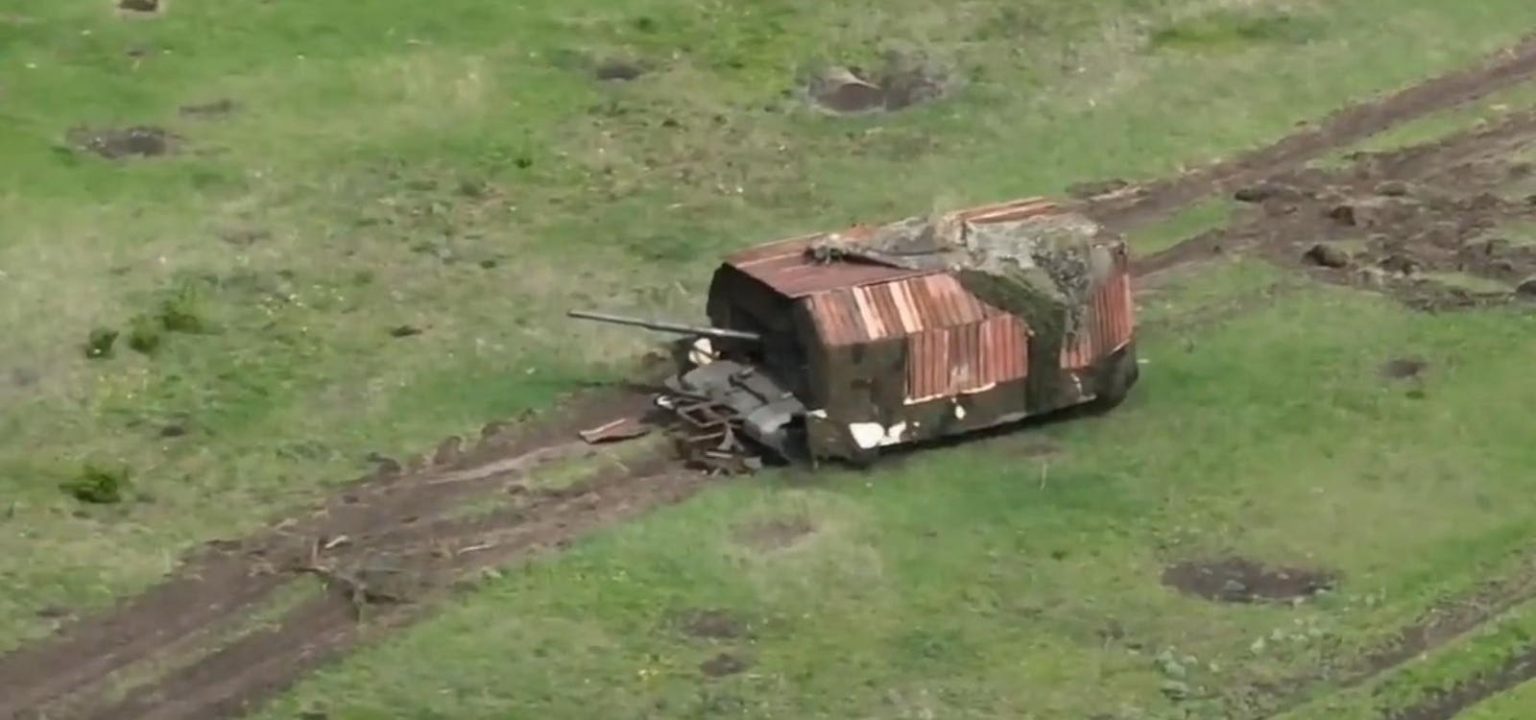Early this month, Ukrainian drone operators were flabbergasted to spot, on the battlefield outside Krasnohorivka—just west of Donetsk in eastern Ukraine—a Russian T-72 tank with what appeared to be a metal roof atop its hull and turret.
Incredibly, the bizarre up-armored tank wasn’t a one-off. In fact, it launched a vehicular trend in the Russian army in Ukraine as more and more Russian crews came around to the idea that the strange improvised armor might actually work.
The problem is, it only works against one particular Ukrainian munition. And the Ukrainians are about to expand their arsenal with munitions the DIY tanks probably can’t defeat.
It was obvious what that three-person Russian crew outside Krasnohorivka was trying to do: put up a shield between its 51-ton tank and the thousands of explosive first-person-view drones Ukrainian forces launch every day.
It was equally obvious that the shell-like armor—which inspired the derisive “turtle tank” moniker—would probably come with serious drawbacks. Its vertical posts would prevent the tank’s turret from rotating. The bulk would impede visibility and mobility. And the installation seemingly left a gap in the front for a skilled FPV operator to fly their drone through.
Observers laughed at the awkward turtle tank. And they laughed harder when the first turtle tank survived its combat debut—an assault on Ukrainian positions in Krasnohorivka—only to apparently get blown up in an artillery barrage targeting its base in Donetsk.
But the turtle tanks kept coming. Three weeks later, they’re a common sight all along the eastern front of Russia’s 26-month wider war on Ukraine.
Often sporting anti-drone radio jammers on their shells and mine-clearing rollers on their hulls, the tanks have led several assaults on Krasnohorivka. At least one was damaged and immobilized; Russian troops towed it off the battlefield.
Most of the turtle tanks belong to the 5th Motor Rifle Brigade, a former Ukrainian separatist unit that joined the Russian army last year. The 5th Motor Rifle Brigade has always made do with whatever weapons it can beg, borrow or steal.
But now turtle tanks are also showing up in the workshops of better-equipped Russian units—including the 90th Tank Division, which is lurking around the ruins of the eastern city of Avdiivka, possibly waiting to exploit the gap Russian troops recently opened in Ukrainian lines around the village of Ocheretyne.
The Russian army isn’t always particularly careful with its equipment and the lives of its troops, but it isn’t—as an institution—stupid. If turtle tanks are proliferating, it’s probably because they’re solving some problem.
“I know people are laughing at this, but I don’t think it is a crazy adaptation,” wrote Rob Lee, an analyst with the Foreign Policy Research Institute in Philadelphia. “The Russians are adapting to the particular conditions of the battlefield.”
The conditions are that, for the past six months, Ukraine has been starved for ammunition—owing mostly to a long delaying campaign by Russia-friendly Republicans in the U.S. House of Representatives, who blocked further U.S. aid to Ukraine starting in October.
That campaign collapsed amid intensive pressure this month. More than $60 billion in fresh U.S. aid is coming to Ukraine through the end of the year; the first batch of munitions, worth $1 billion, is already on the way.
While starving for ammo—in particular, American-made artillery shells and Javelin anti-tank missiles—Ukraine compensated by propping up a nationwide network of small workshops producing as many as 100,000 inexpensive FPV drones every month. Each radio-controlled drone ranges several miles with a one-pound warhead.
To be clear, a strike by a single FPV is unlikely to destroy a 51-ton tank protected by hundreds of millimeters of composite armor. Multiple hits might do the job, but it helps for a mine, missile or shell to immobilize a tank before the lightweight drones barrel in. “FPV drones are not the key,” explained a Ukrainian drone operator with the call-sign “Kriegsforscher.”
It’s true that drones might not outright destroy a lot of undamaged tanks and other heavy armored vehicles, but they can be instantly lethal to infantry. Analysts have documented thousands of FPV drone strikes on exposed Russian troops.
In any event, as building and launching FPVs became the Ukrainians’ priority, protecting against the tiny drones became the Russians’ priority. That meant shell-like armor and piles of radio jammers for a growing number of tanks.
It doesn’t matter right now that the add-on protection does nothing to defeat artillery or anti-tank missiles—or worse, actually makes a vehicle more vulnerable to artillery or anti-tank missiles by limiting its visibility and mobility. After all, the Ukrainians began running out of those heavier munitions months ago. They’re not the main danger on the battlefield.
The Russian custom, it seems, is to send one turtle tank fitted with jammers and mine-rollers ahead of other vehicles—often laden with infantry—to clear a safe path right up to Ukrainian lines.
“Sacrificing observation and the ability to rotate the turret on one tank per platoon that can jam many FPVs’ frequencies at once makes sense,” Lee wrote. “The priority is to get infantry assault groups across open fields to buildings or defensive positions.”
For that purpose, in the current environment, the turtle tanks appear to be working just fine. The problem, for the Russians, is that the environment is about to change. The first batch of fresh U.S. aid should arrive in Ukraine any day now—and it includes hundreds of millions of dollars worth of artillery shells and anti-tank missiles. It’s a safe bet subsequent U.S. aid packages will include even more shells and missiles.
The FPVs aren’t going away. But neither are they going to remain the main—practically only—Ukrainian munition on the battlefield. How will the lumbering turtle tanks, and their mostly blind crews, fare when the Ukrainians are firing 100-pound shells and 35-pound missiles at them in addition to two-pound drones?
We’re about to find out.
Sources:
1. Rob Lee: https://twitter.com/RALee85/status/1783558203239788920
2. Kriegsforscher: https://twitter.com/OSINTua/status/1780531798432203096
3. Naalsio: https://twitter.com/naalsio26/status/1783536002809598178
4. Ukraine Control Map: https://www.google.com/maps/d/viewer?mid=180u1IkUjtjpdJWnIC0AxTKSiqK4G6Pez&hl=en_US&ll=47.97100103974949%2C37.60214693282037&z=13
Read the full article here





